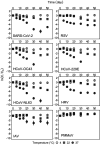Persistence of human respiratory viral RNA in wastewater-settled solids
- PMID: 38501669
- PMCID: PMC11022535
- DOI: 10.1128/aem.02272-23
Persistence of human respiratory viral RNA in wastewater-settled solids
Abstract
Wastewater-based epidemiology has emerged as a valuable tool for monitoring respiratory viral diseases within communities by analyzing concentrations of viral nucleic-acids in wastewater. However, little is known about the fate of respiratory virus nucleic-acids in wastewater. Two important fate processes that may modulate their concentrations in wastewater as they move from household drains to the point of collection include sorption or partitioning to wastewater solids and degradation. This study investigated the decay kinetics of genomic nucleic-acids of seven human respiratory viruses, including severe acute respiratory syndrome coronavirus 2 (SARS-CoV-2), respiratory syncytial virus (RSV), human coronavirus (HCoV)-OC43, HCoV-229E, HCoV-NL63, human rhinovirus (HRV), and influenza A virus (IAV), as well as pepper mild mottle virus (PMMoV) in wastewater solids. Viruses (except for PMMoV) were spiked into wastewater solids and their concentrations were followed for 50 days at three different temperatures (4°C, 22°C, and 37°C). Viral genomic RNA decayed following first-order kinetics with decay rate constants k from 0 to 0.219 per day. Decay rate constants k were not different from 0 for all targets in solids incubated at 4°C; k values were largest at 37°C and at this temperature, k values were similar across nucleic-acid targets. Regardless of temperature, there was limited viral RNA decay, with an estimated 0% to 20% reduction, over the typical residence times of sewage in the piped systems between input and collection point (<1 day). The k values reported herein can be used directly in fate and transport models to inform the interpretation of measurements made during wastewater surveillance.IMPORTANCEUnderstanding whether or not the RNA targets quantified for wastewater-based epidemiology (WBE) efforts decay during transport between drains and the point of sample collection is critical for data interpretation. Here we show limited decay of viral RNA targets typically measured for respiratory disease WBE.
Keywords: human respiratory viruses; persistence; wastewater solids; wastewater-based epidemiology.
Conflict of interest statement
The authors declare no conflict of interest.
Figures


Similar articles
-
Sewer transport conditions and their role in the decay of endogenous SARS-CoV-2 and pepper mild mottle virus from source to collection.Int J Hyg Environ Health. 2025 Jan;263:114477. doi: 10.1016/j.ijheh.2024.114477. Epub 2024 Oct 7. Int J Hyg Environ Health. 2025. PMID: 39378553
-
Wastewater concentrations of human influenza, metapneumovirus, parainfluenza, respiratory syncytial virus, rhinovirus, and seasonal coronavirus nucleic-acids during the COVID-19 pandemic: a surveillance study.Lancet Microbe. 2023 May;4(5):e340-e348. doi: 10.1016/S2666-5247(22)00386-X. Epub 2023 Mar 22. Lancet Microbe. 2023. PMID: 36965504 Free PMC article.
-
Effective method to mitigate impact of rain or snowmelt sewer flushing events on wastewater-based surveillance measurements.Sci Total Environ. 2024 Dec 15;956:177351. doi: 10.1016/j.scitotenv.2024.177351. Epub 2024 Nov 5. Sci Total Environ. 2024. PMID: 39489448
-
Respiratory virus concentrations in human excretions that contribute to wastewater: a systematic review and meta-analysis.J Water Health. 2023 Jun;21(6):831-848. doi: 10.2166/wh.2023.057. J Water Health. 2023. PMID: 37387346
-
Role of pepper mild mottle virus as a tracking tool for fecal pollution in aquatic environments.Arch Microbiol. 2022 Jul 22;204(8):513. doi: 10.1007/s00203-022-03121-3. Arch Microbiol. 2022. PMID: 35864362 Free PMC article. Review.
Cited by
-
West Nile Virus (Orthoflavivirus nilense) RNA concentrations in wastewater solids at five wastewater treatment plants in the United States.PeerJ. 2025 Jul 23;13:e19748. doi: 10.7717/peerj.19748. eCollection 2025. PeerJ. 2025. PMID: 40718785 Free PMC article.
-
Methodic aspects of influenza and respiratory syncytial virus detection in raw wastewater and presence in treatment plants in southeastern Germany.Sci Rep. 2025 Aug 2;15(1):28194. doi: 10.1038/s41598-025-13998-x. Sci Rep. 2025. PMID: 40750655 Free PMC article.
-
Wastewater-Based Surveillance of Respiratory Syncytial Virus Reveals a Temporal Disconnect in Disease Trajectory across an Active International Land Border.Environ Health (Wash). 2025 Jan 29;3(4):425-435. doi: 10.1021/envhealth.4c00168. eCollection 2025 Apr 18. Environ Health (Wash). 2025. PMID: 40270530 Free PMC article.
-
Spatiotemporal Variability of the Pepper Mild Mottle Virus Biomarker in Wastewater.ACS ES T Water. 2024 Dec 16;5(1):341-350. doi: 10.1021/acsestwater.4c00866. eCollection 2025 Jan 10. ACS ES T Water. 2024. PMID: 39816978 Free PMC article.
-
Human pathogen nucleic acids in wastewater solids from 191 wastewater treatment plants in the United States.Sci Data. 2024 Oct 17;11(1):1141. doi: 10.1038/s41597-024-03969-8. Sci Data. 2024. PMID: 39420189 Free PMC article.
References
-
- Peccia J, Zulli A, Brackney DE, Grubaugh ND, Kaplan EH, Casanovas-Massana A, Ko AI, Malik AA, Wang D, Wang M, Warren JL, Weinberger DM, Arnold W, Omer SB. 2020. Measurement of SARS-CoV-2 RNA in wastewater tracks community infection dynamics. Nat Biotechnol 38:1164–1167. doi:10.1038/s41587-020-0684-z - DOI - PMC - PubMed
-
- Fernandez-Cassi X, Scheidegger A, Bänziger C, Cariti F, Tuñas Corzon A, Ganesanandamoorthy P, Lemaitre JC, Ort C, Julian TR, Kohn T. 2021. Wastewater monitoring outperforms case numbers as a tool to track COVID-19 incidence dynamics when test positivity rates are high. Water Res 200:117252. doi:10.1016/j.watres.2021.117252 - DOI - PMC - PubMed
-
- Feng S, Roguet A, McClary-Gutierrez JS, Newton RJ, Kloczko N, Meiman JG, McLellan SL. 2021. Evaluation of sampling, analysis, and normalization methods for SARS-CoV-2 concentrations in wastewater to assess COVID-19 burdens in Wisconsin communities. ACS EST Water 1:1955–1965. doi:10.1021/acsestwater.1c00160 - DOI
-
- Wu F, Zhang J, Xiao A, Gu X, Lee WL, Armas F, Kauffman K, Hanage W, Matus M, Ghaeli N, Endo N, Duvallet C, Poyet M, Moniz K, Washburne AD, Erickson TB, Chai PR, Thompson J, Alm EJ. 2020. SARS-CoV-2 titers in wastewater are higher than expected from clinically confirmed cases. mSystems 5:e00614-20. doi:10.1128/mSystems.00614-20 - DOI - PMC - PubMed
Publication types
MeSH terms
Substances
Supplementary concepts
Grants and funding
LinkOut - more resources
Full Text Sources
Miscellaneous

